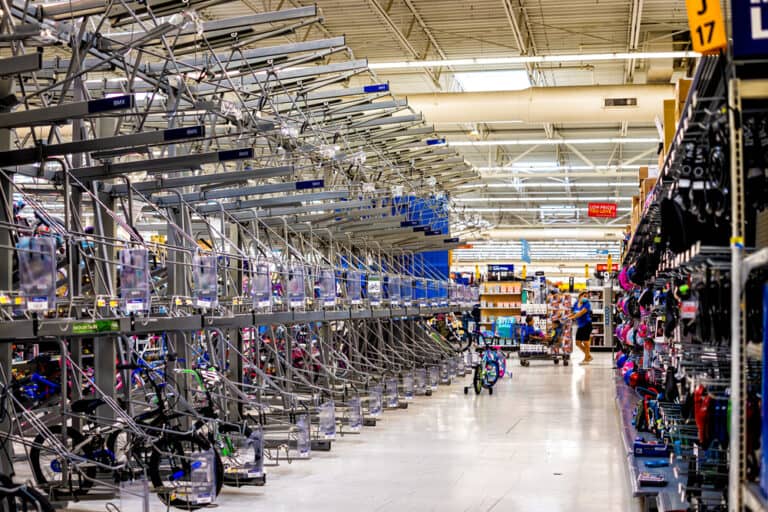Are Specialized Bikes Good?

Editorial credit: Jurij_K / Shutterstock.com
Along with Trek and Giant bicycles, Specialized is one of the biggest bike brands in the United States today. Yet being the biggest does not necessarily mean the best. The question, therefore, has to be asked, are Specialized bikes any good?
An innovative bicycle company focused extensively on R&D, Specialized is regarded as one of the best bike brands in the world, producing state-of-the-art bikes using good quality materials. It stands to reason, therefore, that Specialized has an excellent reputation in the cycling industry.
Choosing a good bike can be daunting. As with anything from the tastiest bolognese sauce to the best holiday destination, everyone has an opinion, and the best bikes are no exception. Specialized is one bicycle brand that consistently comes up in the top three in its class. Is Specialized worthy of the accolades, and what makes them so good?
Specialized Bikes: A Modern Tale
Specialized has a fairly recent history. It has come a long way in a little under 50 years, cementing its place in modern biking legend. Founded in San Jose by Mike Sinyard in 1974, this Morgan Hill, California company comes from humble beginnings.
Certain high-quality bike parts, particularly the reputable Italian ones, were difficult to come by in the US in the early 1970s. After selling his VW Kombi to fund his trip to a European cycle tour and bringing back some Cinelli bike components, Sinyard saw a gap in the market.
In relatively short order, Sinyard began manufacturing his own components and, by 1976, introduced the Specialized Touring Tire. By 1981 the first two complete bikes were released, the Allez, a road bike, and the Sequoia, a touring sport design.
Later in the same year, Specialized brought out the first full-production mountain bike in the world. Named “Stumpjumper,” Specialized still produces hardtail and full-suspension variants under the Stumpjumper name today, and an original 1981 model can be seen on display in the Smithsonian Museum in Washington, DC.
Being a frontrunner in modern bike design, by 1989, Specialized released the “Epic,” described as the second carbon-fiber bike to be mass produced worldwide. By the early 90s, the “Globe” range of bikes arrived. They were so successful that by 2009 Globe broke away and became a distinct brand.
Globe has since been discontinued. Specialized now marketing the Globe urban “lifestyle” bikes under their name. The department store bikes trend introduced in the 1990s saw Specialized selling their “Full Force” budget mountain bike range through this channel.
Angry Specialized dealerships saw this as a major threat. The move also impacted Specialized’s market share, and the company was forced to apologize after pulling the Full Force range from department stores. Their sales plummeted by around a third, and Specialized nearly closed its doors.
In 2001, Merida Bikes, a Taiwanese bicycle manufacturer, bought a 49% stake in Specialized for US$30 million. Mike Sinyard kept his controlling share and remained CEO of the company. Today, Specialized is one of the top bike brands in the United States, along with Trek and Giant.
The Specialized Guiding Philosophy
Post World War 2 until around the early 1970s saw little innovation in bicycle style and design. For decades most people had a choice of daily commuter or road racer. This has changed recently, with more discerning cyclists seeking alternative designs that suit their specific needs.
The BMX revolution of the early 1970s, inspired by motocross, helped inspire the mountain bike styles that are very popular today. These all-terrain bikes allow offroad adventure biking with sturdier frames, wide knobby tires, and innovative suspension designs.
Specialized has always been tuned in to the consumer’s needs. “Made by the riders for the riders” means that the company has always anticipated what riders in different cycling disciplines value. Seeing bikers enthusiastically take to the dirt meant they were early adopters of mountain biking.
The company has always aimed to be “specialized,” and through their guiding motto, “Innovate or Die,” they have invested more than most other bike manufacturers in R&D. They have built a wind tunnel to test their aerodynamic designs and made the transition to lightweight carbon-fiber frames more quickly than most of the competition.
Specialized Bikes, Innovation Built To Last
Specialized bikes are not the cheapest around. It stands to reason, though, as they are designed to last a lifetime, making them a worthy investment, especially for the serious cyclist. Throughout its relatively short history, Specialized have demonstrated a pioneering attitude to the bike frame and wheel rim design, reflecting their build quality.
In 1989, long before any of their competitors saw it coming, Specialized, in partnership with Duralcan Corp, produced a new aluminum-based metal-matrix wheel rim and quickly released 5000 units into the market.
With several international companies’ involvement, these rims were fitted to the now popular mountain bikes by 1990. In the same year, they released the composite wheel in a joint venture with Du Pont.
In 1996, Specialized released the first affordable carbon-fiber mountain bike, the Stumpjumper Epic, which now made this high-quality lightweight technology accessible to the average Joe. Sinyard was honored and inducted into the Mountain Bike Hall of Fame for his efforts.
After a number of eminent physicians raised the alarm, the much-hyped link between cycling and male impotence prompted Specialized to invest in the Body Geometry bicycle seat. Developed by a medical doctor, this seat is intended to shift the biker’s body weight from the perineal area to the seat.
Specialized continues to lead the way in its innovative bike design and manufacturing approach. Frames made from composite and carbon-fiber materials, lightweight helmets, physician-designed seats, and 3 spoke wheels have contributed to excellent performance and quality.

Specialized PR And Marketing
Brand image, reputation, and marketing are cornerstones of growth and sustainability in a free market world. Specialized people understand this very well and have spent bucket loads of money and effort to ensure that their advertising and public relations investments produce healthy returns.
Professional cyclists are impatient and constantly seeking new ways to reduce weight and increase race speed. Consumers can take comfort in the assurance that when Specialized announces new innovations or products, they will typically become available to the public within a year.
In 1990, Soviet leader Mikhail Gorbachev was a popular figure in the west. The USSR was flailing, and Gorbachev, through his reforms, was in the process of dismantling the communist monolith. Specialized decided to use his image in an ad campaign riding a bicycle wearing the soviet cycling uniform and holding a specialized helmet.
The famous port wine stain on Gorbachev’s head resembled the Specialized logo, and a caption was added: “Mr. Gorbachev is riding a Specialized Sirrus.” Although this advert raised some ethical and privacy concerns in advertising circles, it did elevate Specialized as a brand, and the company continued to flight the advert.
Specialized has partnered with many popular brands in the past, such as Mountain Dew and Subaru, to sponsor various community-based initiatives such as the Specialized BMX Program. They transformed inner city parks into permanent fixtures for BMX riders and skateboarders in major cities such as New York, Los Angeles, Chicago, and Miami.
Specialized early adopters of the internet have used the World Wide Web to their benefit. While other bike brands were still using catalogs and magazines to market their products, Specialized skillfully used their online presence to increase brand awareness and foster customer loyalty.
An honest, open relationship with consumers makes for a healthy long-term relationship. As part of their enduring commitment to product excellence, Specialized has demonstrated this by recalling 12000 units sold between 2007 and 2012 due to a faulty fork found in the front. This affected the Globe product line as well.
Specialized Branded Product Quality
Although Specialized bike parts are manufactured in Taiwan by Merida, the final products are designed and tested at the sprawling Specialized plant in Morgan Hill, California. Some lower-end bikes are manufactured in China by Giant Bicycles, thanks to their advanced facilities.
Most of the leading bike manufacturers also produce their range of branded products. Specialized make excellent bike components, including tires, saddles, seat posts, and stems. The Specialized Website is an excellent resource for all its merchandise, including bikes, components, equipment, and cycling apparel.
Specialized bikes, due to their best-of-breed quality, are not cheap. It is, however, money well spent. Prices range from under US$3000 for the Tarmac Road bike to US$15000 for the Carbon S model. These prices apply to both mountain bikes and pedal-assisted E-bikes.
Long term, the pricier top-end bikes tend to hold their value very well compared to their cheaper counterparts.
Looking To A Specialized Future
Specialized continues to produce successful, high-grade bikes. Faith in the products was demonstrated by the Cycle Response Units of the London Ambulance Service operating Specialized Rockhopper mountain bikes in congested urban areas.
Specialized bikes are built to last. A challenge for E-bikes, on the other hand, has been the longevity of their batteries. Lasting a mere 4 to 6 years before running out of juice, Specialized has teamed up with ex-Tesla co-founder and CTO Jeffrey Straubel of Redwood Materials to find a solution to the issue of sustainable recycling.
Specialized will recover and ship redundant batteries to Redwood’s Nevada recycling facility through its retail and dealer network. Reusable materials such as wire, plastics, and connectors will be removed, and the remainder will be processed and refined to extract nickel, cobalt, and copper.
The idea behind this is to recycle hazardous materials responsibly while extracting useful elements that can be used to make new batteries.
Conclusion
Specialized bikes are regarded as some of the best in the world. Durable and reliable, they are built to last. And with their extensive global dealer network and top-notch after-sales service, owning a Specialized bike is sure to keep a smile on your face for years to come.







